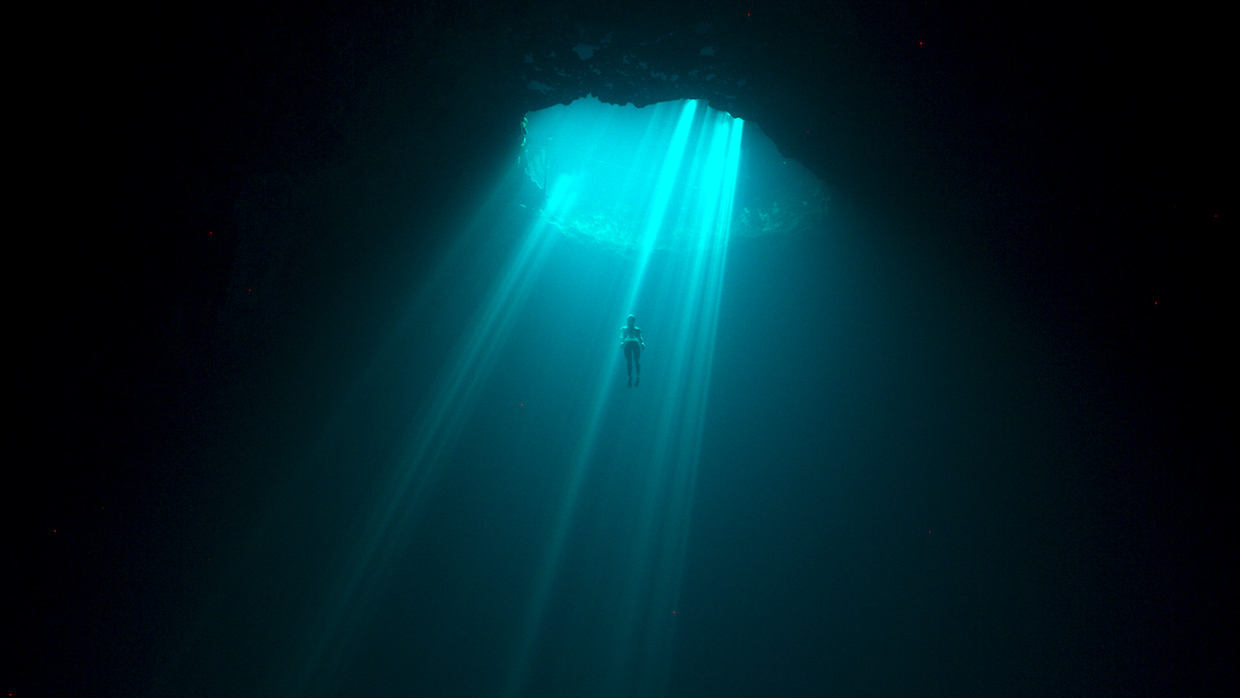 Back to selection
Back to selection
“An Escape to the Coolest Boho Pad on the Beach”: DP Tim Cragg on The Deepest Breath
 The Deepest Breath, courtesy of Sundance Institute.
The Deepest Breath, courtesy of Sundance Institute.
Italian freediver Alessia Zecchini and Irish safety diver Stephen Keenan set their sights on the famous Blue Hole located 184 feet below the Red Sea in The Deepest Breath from documentary filmmaker Laura McGann. Hell-bent on breaking a new world record, Alessia trains to make the seemingly impossible oceanic descent by holding one single breath without the aid of any scuba gear.
Cinematographer Tim Cragg discusses his artistic vision on the shoot, which also featured technological complications.
See all responses to our annual Sundance cinematographer interviews here.
Filmmaker: How and why did you wind up being the cinematographer of your film? What were the factors and attributes that led to your being hired for this job?
Cragg: I was contacted by director Laura McGann in November 2020, we have a strong connection and she shared with me her vision of the film and the approach picked up quickly. With such a passionate director onboard; Ventureland, Motive, RAW and A24 as producers; a great story to work with; and amazing locations—Italy, Egypt, Bahamas; I was excited to be part of this adventure.
Filmmaker: What were your artistic goals on this film, and how did you realize them? How did you want your cinematography to enhance the film’s storytelling and treatment of its characters?
Cragg: We wanted the film to feel like an escape to the coolest boho pad on the beach where the viewer is transported into hearing intimate conversations with some of the world’s top free diving athletes—sun-kissed and living a truly heroic adventurous lives, bouncing from diving spot to diving spot around the world. We also wanted to capture a sense of the locations: ocean, beaches and interiors, sun flare, sand, clear water and salty skin—the essence of their world.
Filmmaker: Were there any specific influences on your cinematography, whether they be other films, or visual art, of photography, or something else?
Cragg: Laura and I both loved the large scale black and white seascapes of the Japanese photographer Hiroshi Sugimoto and the work of photographer Corey Arnold who captured the relationship between human beings and the ocean in his images on Fish-Work: The Bering Sea.
Filmmaker: What were the biggest challenges posed by production to those goals?
Cragg: Due to the pandemic, we had difficulty reaching all the various locations: Dahab, Prague, Rome, Nice, Blue Hole Bahamas, L.A. and Yuctan. COVID regulations varied from each of these locations with production.
Filmmaker: What camera did you shoot on? Why did you choose the camera that you did? What lenses did you use?
Cragg: We photographed this on a RED Gemini 5K camera with Cooke Anamorphic Lenses. We wanted the character of the internal glow that the Cooke lenses create, which adds to this heightened reality.
Filmmaker: Describe your approach to lighting.
Cragg: It was all location work so we were limited to taking only a small lighting package that we could run off the mains. We mostly used Aputure lighting as the technology allows for less power driven lamps head whilst not sacrificing the power of the light. I used negative fill but had a continual conflict with how much I could bring the 12 x 12 black into the negative side—whilst not making the subjects feel hemmed in with all the kit. We had a power cut in the Bahamas where we had to light the interview with batteries on the lights.
Filmmaker: What was the most difficult scene to realize and why? And how did you do it?
Cragg: The above. We had to work out what lights we could run for three hours on the batteries and still have enough power to make it compete with the exterior ambient level.
Filmmaker: Finally, describe the finishing of the film. How much of your look was “baked in” versus realized in the DI?
Cragg: We shot with a LUT—Low Contrast Rec 709A and then created a look with colourist Vicki Matich at Molinare London.
TECH BOX
Film Title: The Deepest Breath
Camera: RED Gemini 5K
Lenses: Cooke Anamorphic 2x
Lighting: Aputure Various
Color Grading: Molinare Vicki Matich
